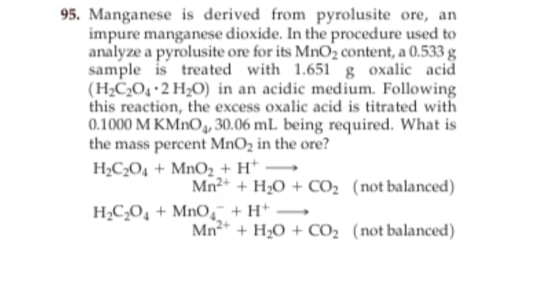Manganese is derived from pyrolusite ore, an impure manganese dioxide. In the procedure used to analyze a pyrolusite ore for its MnO2 content, a 0.533 g sample is treated with 1.651 g oxalic acid (H;C;O4•2 H¿O) in an acidic medium. Following this reaction, the excess oxalic acid is titrated with 0.1000 M KMNO, 30.06 mL being required. What is the mass percent MnO2 in the ore? H;C¿O4 + MnO2 + H* Mn2+ + H;0 + CO: (not balanced) H;C,O, + MnO, +H* Mn + H;O + CO; (not balanced)
Manganese is derived from pyrolusite ore, an impure manganese dioxide. In the procedure used to analyze a pyrolusite ore for its MnO2 content, a 0.533 g sample is treated with 1.651 g oxalic acid (H;C;O4•2 H¿O) in an acidic medium. Following this reaction, the excess oxalic acid is titrated with 0.1000 M KMNO, 30.06 mL being required. What is the mass percent MnO2 in the ore? H;C¿O4 + MnO2 + H* Mn2+ + H;0 + CO: (not balanced) H;C,O, + MnO, +H* Mn + H;O + CO; (not balanced)
Chemistry & Chemical Reactivity
10th Edition
ISBN:9781337399074
Author:John C. Kotz, Paul M. Treichel, John Townsend, David Treichel
Publisher:John C. Kotz, Paul M. Treichel, John Townsend, David Treichel
Chapter4: Stoichiometry: Quantitative Information About Chemical Reactions
Section4.9: Spectrophotometry
Problem 2.1ACP: Excess KI is added to a 100.0-mL sample of a soft drink that had been contaminated with bleach,...
Related questions
Question

Transcribed Image Text:95. Manganese is derived from pyrolusite ore, an
impure manganese dioxide. In the procedure used to
analyze a pyrolusite ore for its MnO2 content, a 0.533 g
sample is treated with 1.651 g oxalic acid
(H;CO, 2 H2O) in an acidic medium. Following
this reaction, the excess oxalic acid is titrated with
0.1000 M KMNO, 30.06 mL being required. What is
the mass percent MnO2 in the ore?
H;C;O4 + MnO2 + H* →
Mn2+ + H;0 + CO; (not balanced)
H;C,O, + MnO, +H* •
-
Mn* + H20 + CO2 (not balanced)
Expert Solution
This question has been solved!
Explore an expertly crafted, step-by-step solution for a thorough understanding of key concepts.
This is a popular solution!
Trending now
This is a popular solution!
Step by step
Solved in 3 steps with 1 images

Knowledge Booster
Learn more about
Need a deep-dive on the concept behind this application? Look no further. Learn more about this topic, chemistry and related others by exploring similar questions and additional content below.Recommended textbooks for you

Chemistry & Chemical Reactivity
Chemistry
ISBN:
9781337399074
Author:
John C. Kotz, Paul M. Treichel, John Townsend, David Treichel
Publisher:
Cengage Learning

Principles of Modern Chemistry
Chemistry
ISBN:
9781305079113
Author:
David W. Oxtoby, H. Pat Gillis, Laurie J. Butler
Publisher:
Cengage Learning

Chemistry by OpenStax (2015-05-04)
Chemistry
ISBN:
9781938168390
Author:
Klaus Theopold, Richard H Langley, Paul Flowers, William R. Robinson, Mark Blaser
Publisher:
OpenStax

Chemistry & Chemical Reactivity
Chemistry
ISBN:
9781337399074
Author:
John C. Kotz, Paul M. Treichel, John Townsend, David Treichel
Publisher:
Cengage Learning

Principles of Modern Chemistry
Chemistry
ISBN:
9781305079113
Author:
David W. Oxtoby, H. Pat Gillis, Laurie J. Butler
Publisher:
Cengage Learning

Chemistry by OpenStax (2015-05-04)
Chemistry
ISBN:
9781938168390
Author:
Klaus Theopold, Richard H Langley, Paul Flowers, William R. Robinson, Mark Blaser
Publisher:
OpenStax


Chemistry & Chemical Reactivity
Chemistry
ISBN:
9781133949640
Author:
John C. Kotz, Paul M. Treichel, John Townsend, David Treichel
Publisher:
Cengage Learning

Chemistry: The Molecular Science
Chemistry
ISBN:
9781285199047
Author:
John W. Moore, Conrad L. Stanitski
Publisher:
Cengage Learning